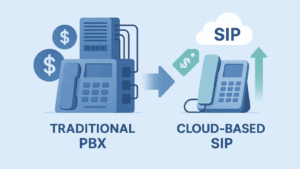
Choosing Cloud SIP Providers: A Decision Guide
Cloud SIP providers are transforming how businesses manage their communication needs. These providers facilitate the transition from traditional PBX systems to internet-based phone systems, offering a more flexible, scalable, and cost-effective solution for modern business communications. SIP trunking operates through Voice over Internet Protocol (VoIP), converting voice signals into digital data for transmission over the internet. Switching To SIp trunking can reduce telecommunication costs and offer features unique to cloud services.
Selecting the right SIP trunking provider ensures reliability, cost-efficiency, and scalability. A suitable provider helps businesses achieve significant cost savings, enhance communication capabilities, and support growth. This guide offers a step-by-step decision-making process to help you select a provider that meets your unique business needs.
Understanding Cloud SIP Trunking
A SIP trunk is essentially a single virtual phone line that allows you to make calls over the internet. Unlike a traditional phone line that relies on physical connections, SIP trunking uses VoIP technology to support various communication channels, including voice, SMS texting, and video conferencing. VoIP facilitates the transmission of voice and digital media over the internet, enabling efficient and versatile communication for businesses.
The main benefits of cloud SIP trunking include cost reduction, scalability, and increased reliability compared to traditional phone systems. Businesses can gain flexibility and advanced call features by transforming a traditional PBX into a cloud-based phone network, potentially resulting in significant cost savings. Hosted SIP providers offer business VoIP software that integrates multiple communication channels for seamless operations.
Cloud SIP trunking integrates your entire communication infrastructure into a unified, efficient system. Businesses can manage voice, video, and messaging on a single network, reducing complexity and improving overall communication efficiency.
Why Businesses Are Moving to Cloud-Based Solutions
Flexibility and scalability are among the top reasons why businesses are moving to cloud-based solutions. Cloud SIP trunking allows businesses to adjust their communication infrastructure as they grow or adapt to changing needs, removing the need for significant hardware investments. Flexibility is especially beneficial for businesses with fluctuating communication demands, as they can scale up or down without incurring substantial costs.
Enhanced reliability and performance are other critical factors. Cloud SIP providers often offer high uptime and robust failover mechanisms to ensure continuous business operations.
Additionally, cloud-based systems support remote work more effectively, allowing employees to access the communication platform from anywhere with an internet connection. This feature is vital for today’s distributed workforce, making cloud SIP trunking a future-proof technology that keeps businesses current with the latest communication advancements.
Key Factors to Evaluate When Choosing a Provider
Reliability and uptime guarantees should be prioritized when choosing a SIP trunking provider. Downtime can severely impact business operations, so selecting a provider with a strong reliability track record is essential. Quality of Service (QoS) policies are equally important. QoS prioritizes voice data to maintain optimal call quality, ensuring clear and uninterrupted communications.
Compatibility with your current infrastructure is another important consideration. Ensure that the SIP trunking provider you choose can integrate seamlessly with your existing VoIP system and supports various media types, including voice, video, and messaging.
Also, seek providers that offer scalability and flexibility to grow with your business. Security measures and compliance standards are critical, especially if your business handles sensitive information.
How to Determine the Right Number of SIP Trunks for Your Business
If you’re considering SIP trunking, you might wonder how many sip trunks you will need for your operations. Determining the appropriate number begins with an evaluation of your current and anticipated call volume.
Each SIP trunk can handle one concurrent call, so the first step is to assess your peak calling times and the number of simultaneous calls your business typically handles. For example, a small business with moderate call traffic may require only a few trunks, whereas a larger organization with a call center might need dozens. By analyzing call patterns, you can ensure your system is neither underutilized nor overwhelmed, optimizing operational efficiency.
Another key consideration is scalability. Modern SIP trunking solutions allow businesses to add or remove trunks as needed without significant delays or technical challenges. Your communication system can grow alongside your business, accommodating increases in staff, new locations, or seasonal spikes in call volume. Businesses seeking to future-proof their communication infrastructure should prioritize solutions that support easy scalability with minimal downtime or disruption.
Finally, the right solution will offer an intuitive control panel, enabling you to manage your SIP trunks and make adjustments in real time. With automated provisioning and a self-service environment, businesses can monitor their usage and adjust capacity to instantly meet demand. By taking these factors into account, you can determine the ideal number of SIP trunks for your organization, ensuring reliable and cost-effective communication that aligns with your operational needs.
Cost Considerations and ROI
Understanding SIP trunking’s cost implications is key to making an informed decision. Metered plans charge a fee per minute for outbound calls, while unmetered plans offer unlimited calling for a set monthly rate. These pricing models help businesses manage their communication budgets more effectively, offering a predictable cost model that eliminates unexpected expenses.
When evaluating cloud SIP providers, compare the long-term value and short-term costs. Although the initial setup and transition to SIP trunking may require an investment, the long-term savings on communication expenses and maintenance can be substantial. SIP trunking typically offers a higher return on investment by reducing the need for physical infrastructure and lowering operational costs.
Advantages of Cloud SIP Providers
A major advantage of cloud SIP trunking is flexibility. Businesses can use local numbers from any location, even when relocating, which simplifies maintaining continuity and managing customer interactions. Scaling phone lines digitally, without additional wiring, allows businesses to effortlessly grow their communication capabilities, including unlimited local calling.
Cloud SIP trunking supports a wide range of communication types, making it more versatile than traditional VoIP. Businesses can self-manage their communication services, enabling quick adjustments to meet evolving needs. Advanced features such as video conferencing and integration with various business applications further enhance communication capabilities and streamline operations.
Cloud SIP providers enhance business operations by offering real-time analytics that provide immediate insights into call performance and usage patterns. These analytics empower businesses to make data-driven decisions, optimizing communication strategies to better align with operational goals and customer needs.
Beyond improving day-to-day efficiency, cloud-based systems also bolster business continuity with robust disaster recovery solutions. Unlike traditional systems that are often vulnerable to outages, these solutions ensure uninterrupted communication by quickly rerouting calls and maintaining access during disruptions. The combination of actionable insights and dependable uptime creates a seamless and resilient communication environment, supporting businesses in both their routine operations and critical moments.
Practical Steps to Make Your Decision
Choosing the right cloud SIP provider impacts the efficiency and reliability of your business communications. By following a structured approach, you can simplify the selection process and ensure the provider you choose aligns with your unique needs. Below are three practical steps to guide you in making an informed choice.
Step 1: Conduct a Needs Assessment
Start by evaluating your organization’s current and future communication requirements. Identify the number of concurrent calls your business handles, the compatibility of your existing hardware, and the features you prioritize, such as scalability, disaster recovery, or user-friendly management tools. By clearly defining these needs, you can narrow down providers that align with your operational goals and technical requirements.
Step 2: Request Trials and Demos
Leverage free trials and demos to test the provider’s features firsthand. A well-designed system will allow you to set up and provision SIP trunks quickly and with minimal effort. Use the trial period to evaluate the platform’s ease of use, performance reliability, and ability to integrate with your existing infrastructure. Hands-on experience is invaluable in confirming the provider’s suitability.
Step 3: Read Reviews and Gather Recommendations
Research reviews and testimonials to understand how other businesses have benefited from the provider’s solutions. Pay attention to feedback about reliability, customer support, and ease of management. Additionally, seek recommendations from industry peers or professional networks to ensure you select a provider with a proven track record of meeting diverse business needs.
By following these steps, you can make an informed decision that ensures your business’s communication system is both efficient and future-ready.
Key Features to Look for in Cloud SIP Trunking Services
When evaluating cloud SIP providers, focus on features that directly impact the reliability and security of your communications. Key considerations such as uptime guarantees, QoS, and robust security measures ensure your system operates seamlessly while safeguarding sensitive data.
Reliability and Uptime
Choosing a SIP provider with a strong reputation for reliability helps minimize downtime and maintain seamless communication. Providers that leverage multiple connections to tier-1 carriers offer enhanced stability, ensuring consistent uptime for their services.
Additionally, infrastructure with built-in redundancies supports superior call quality, even during periods of high demand, by efficiently managing traffic loads. To further solidify reliability, carefully review the provider’s Service Level Agreements (SLAs), which outline specific commitments to uptime and remedies for any disruptions, giving you peace of mind and a clear framework for accountability.
Quality of Service
QoS maintains call clarity and connection reliability, directly influencing the user experience and overall satisfaction with your communication system. High-quality SIP trunk providers prioritize QoS by minimizing latency, jitter, and packet loss, ensuring that calls are clear and uninterrupted, even during peak usage times.
When evaluating a provider, inquire about their QoS mechanisms, such as traffic prioritization and network monitoring, which are designed to maintain consistent performance. Additionally, consider the provider’s track record in handling high call volumes and their ability to adapt to changing network conditions, as these factors can significantly impact the reliability of your business communications.
Security and Compliance
Security and compliance are critical in cloud SIP trunking due to increased cyber threats. Robust security measures like encryption and firewalls are necessary to protect communications against these threats. Session border controllers (SBC) can significantly enhance SIP trunking security by controlling traffic and preventing unauthorized access.
Compliance with regulations like HIPAA and GDPR is also important for SIP providers, especially in sensitive industries. Ensuring your provider meets these standards can protect your business from legal liabilities and ensure the confidentiality and integrity of your communications.
Comparing Cloud SIP Trunking vs Traditional Phone Lines
Cloud SIP trunking offers significant cost savings by reducing hardware and maintenance expenses compared to traditional phone systems. Traditional phone systems require extensive physical infrastructure, while cloud SIP solutions are managed off-site, minimizing the need for on-premises equipment. Switching to a modern solution reduces costs and simplifies the management and scalability of your communication system.
Transitioning to SIP trunking services allows businesses to adjust call volume and add or remove channels based on changing needs. Scalability in cloud SIP trunking is easier, allowing businesses to adjust communication channels quickly without extensive infrastructure changes. Flexibility benefits growing businesses or those with fluctuating communication demands.
Cloud SIP enables broader geographic reach, facilitating communication across multiple locations without traditional systems’ limitations.
Setting Up Cloud SIP Trunking for Your Business
Setting up cloud SIP trunking for your business is a straightforward process with the right provider, allowing you to transition seamlessly to a modern communication system. From provisioning SIP trunks to configuring your existing devices, a step-by-step approach ensures a smooth and efficient implementation.
Assessing Current Infrastructure
Before setting up cloud SIP trunking, evaluate your existing infrastructure for compatibility with SIP technology. Ensure your IP-PBX systems, SIP-enabled devices, or analog gateways are compliant with the standards required by the provider. Many providers support a broad range of devices, simplifying integration and reducing the need for significant hardware upgrades. Verifying these details beforehand ensures a smoother transition and avoids potential technical hurdles during implementation.
Implementation Steps
- Provision SIP Trunks: Use the provider’s control panel to instantly set up and provision the required number of SIP trunks for your business.
- Configure Devices: Update the settings on your IP-PBX or SIP-compliant devices with the credentials and configurations provided.
- Test Call Functionality: Make test calls to ensure call quality, connection reliability, and proper routing across all devices.
- Set Up Call Routing Rules: Customize routing preferences to match your business’s operational needs, such as directing calls to specific departments or locations.
- Monitor Performance: Utilize built-in analytics and monitoring tools to track usage and address any issues during the early stages of deployment.
- Train Your Team: Ensure staff members understand the new system’s capabilities and know how to use the features effectively.
These steps provide a clear roadmap for a hassle-free setup, allowing businesses to quickly leverage the advantages of cloud SIP trunking.
Simplify and Empower Your Communication
Choosing the right cloud SIP provider enhances your business’s communication efficiency, scalability, and cost savings. By conducting a thorough needs assessment, exploring providers with strong reliability and security measures, and leveraging tools like trials and demos, businesses can identify solutions tailored to their goals. A seamless transition to cloud SIP trunking enables organizations to simplify their infrastructure, maintain consistent call quality, and support both current operations and future growth.
Cloud-based SIP trunking solutions leverage existing internet connections to support multiple concurrent communications without requiring significant hardware investments. These systems integrate advanced features such as call management, analytics, and video conferencing, streamlining operations across the organization. Additionally, the flexibility to scale up or down as needed ensures businesses remain agile and ready for change while reducing long-term communication costs.
SIP.US offers a powerful, self-service platform designed to make the move to cloud SIP trunking straightforward and efficient. With features like automated provisioning, real-time analytics, and compatibility with a wide range of devices, SIP.US empowers businesses to optimize their communication strategies with ease. Take the first step toward better business communications—get started today with SIP.US.



